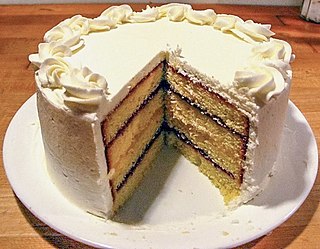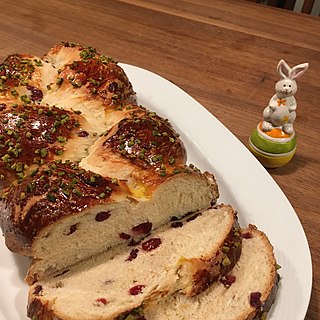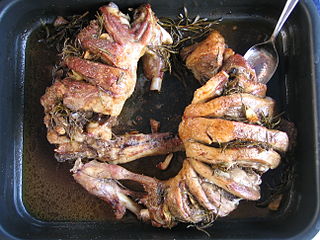
Confectionery is the art of making confections, or sweet foods. Confections are items that are rich in sugar and carbohydrates although exact definitions are difficult. In general, however, confections are divided into two broad and somewhat overlapping categories: bakers' confections and sugar confections.

Cake is a flour confection made from flour, sugar, and other ingredients and is usually baked. In their oldest forms, cakes were modifications of bread, but cakes now cover a wide range of preparations that can be simple or elaborate and which share features with desserts such as pastries, meringues, custards, and pies.

Dutch cuisine is formed from the cooking traditions and practices of the Netherlands. The country's cuisine is shaped by its location on the fertile Rhine–Meuse–Scheldt delta at the North Sea, giving rise to fishing, farming, and overseas trade. Due to the availability of water and flat grassland, the Dutch diet contains many dairy products such as butter and cheese. The court of the Burgundian Netherlands enriched the cuisine of the elite in the Low Countries in the 15th and 16th century, so did in the 17th and 18th century colonial trade, when the Dutch ruled the spice trade, played a pivotal role in the global spread of coffee, and started the modern era of chocolate, by developing the Dutch process chocolate.

Stollen is a fruit bread of nuts, spices, and dried or candied fruit, coated with powdered sugar or icing sugar and often containing marzipan. It is a traditional German Christmas bread. During the Christmas season the cake-like loaves are called Weihnachtsstollen or Christstollen. A ring-shaped Stollen made in a Bundt cake or Gugelhupf pan is called a Stollenkranz.

Simnel cake is a fruitcake associated with Lent and Easter and widely eaten in England, Ireland and countries with patterns of migration from them. It is distinguished by layers of almond paste or marzipan, typically one in the middle and one on top, and a set of eleven balls made of the same paste. It was originally made for the fourth Sunday in Lent, also known as Laetare Sunday, the Refreshment Sunday of Lent, Mothering Sunday, the Sunday of the Five Loaves, or Simnel Sunday; named after the cake. In the United Kingdom, it is now commonly associated with Mothering Sunday and Easter Sunday.

Almond paste is made from ground almonds or almond meal and sugar in equal quantities, with small amounts of cooking oil, beaten eggs, heavy cream or corn syrup added as a binder. It is similar to marzipan, but has a coarser texture. Almond paste is used as a filling in pastries, but it can also be found in chocolates. In commercially manufactured almond paste, ground apricot or peach kernels are sometimes added to keep the cost down.

In many European countries, particularly in Central and Eastern Europe, there are various traditions surrounding the use of bread during the Easter holidays. Traditionally the practice of eating Easter bread or sweetened "communion" bread traces its origin back to Byzantium, Eastern Catholicism and the Orthodox Christian church. The recipe for sweetened or "honey-leavened" bread may date back as far as the Homeric Greek period based on anecdotal evidence from classical texts.

A Konditorei is a business that typically offers a wide variety of pastries and typically also serves as a café. Konditoreien (plural) are found in many countries including but not limited to Germany, Austria, Switzerland, France, Denmark, Sweden, and the Czech Republic. In French-speaking countries, similar businesses are referred to as pâtisseries.

Cake decorating is the art of decorating a cake for special occasions such as birthdays, weddings, baby showers, national or religious holidays, or as a promotional item.

Mazurek is a variety of cake baked in Poland for Easter. It has a flat shape and is very sweet.

The holiday of Easter is associated with various Easter customs and foodways. Preparing, coloring, and decorating Easter eggs is one such popular tradition. Lamb is eaten in many countries, mirroring the Jewish Passover meal.

A spit cake is a European-styled cake made with layers of dough or batter deposited, one at a time, onto a tapered cylindrical rotating spit. The dough is baked by an open fire or a special oven, rotisserie-style. Generally, spit cakes are associated with celebrations such as weddings and Christmas. The spit can be dipped in a thin dough, or the dough can be poured or rolled on the spit.

The Dutch letter is a type of pastry that is typically prepared using a mixture of flour, eggs and butter or puff pastry as its base and filled with almond paste, dusted with sugar and shaped in an "S" or other letter shape. Marzipan, an almond paste prepared with almond meal and honey or sugar, is sometimes used as the filling. The Dutch letter has a porous or airy and flaky texture.























